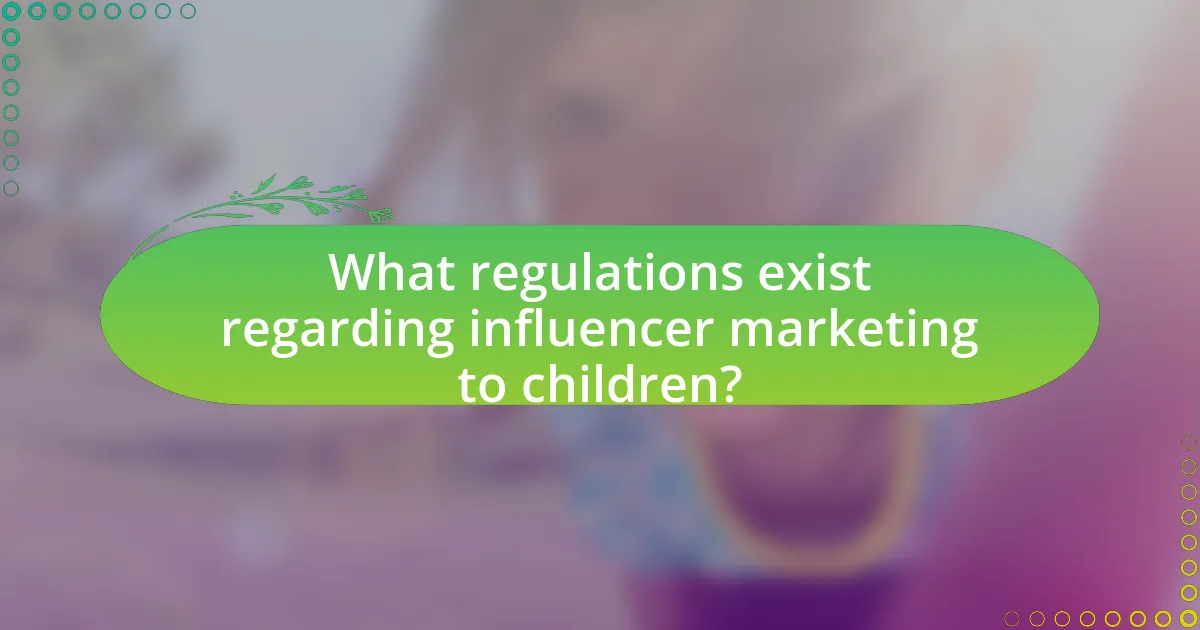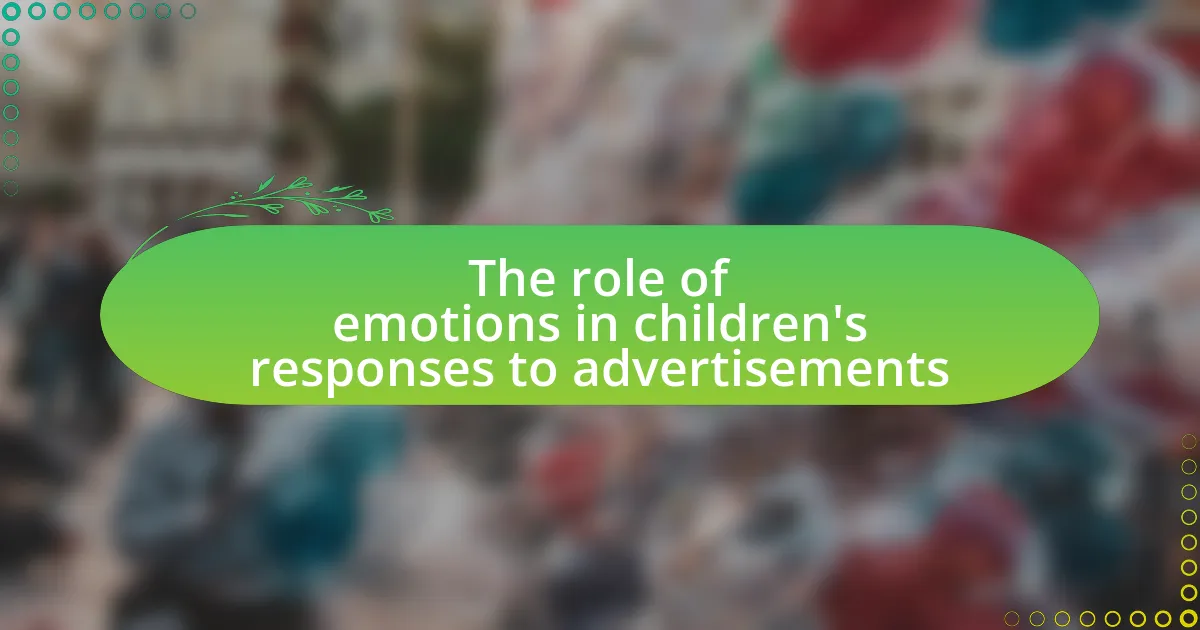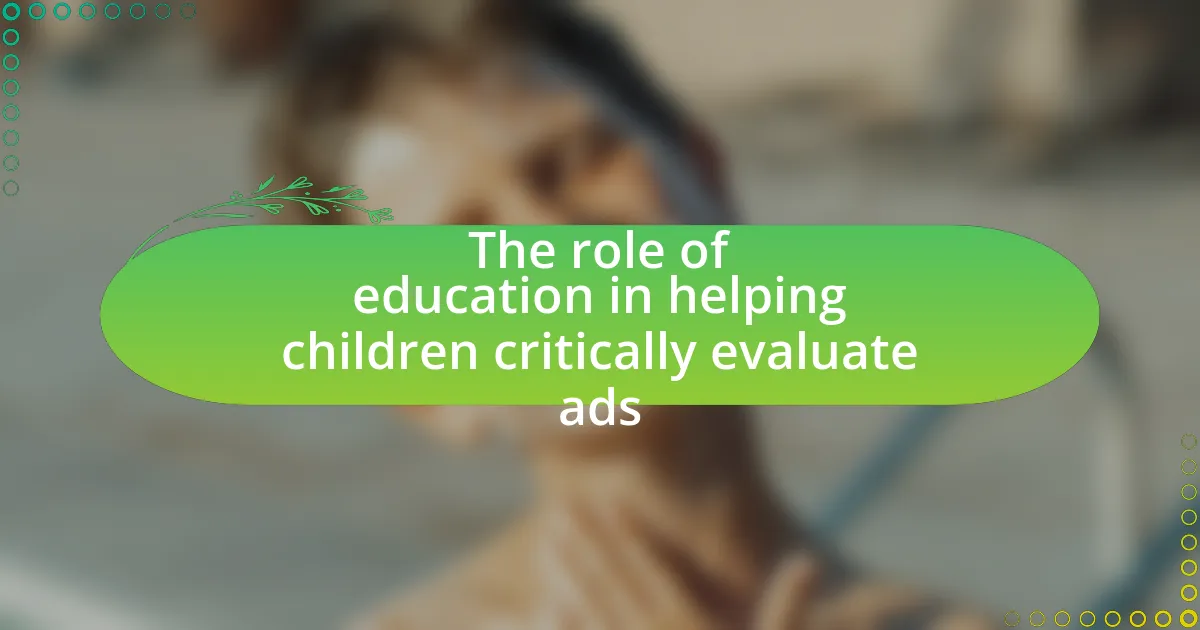The article examines the ethical implications of using influencers in children’s marketing, highlighting concerns about manipulation, exploitation, and the impact on children’s consumer habits. It discusses how influencers shape children’s purchasing decisions through relatable content, the psychological factors that make children susceptible to marketing, and the portrayal of products that can lead to unhealthy behaviors and unrealistic expectations. Additionally, the article outlines existing regulations, differences in international approaches, and the role of social media platforms in safeguarding children. It concludes with recommendations for brands to engage in ethical influencer marketing practices that prioritize transparency and the well-being of young audiences.
What are the ethical implications of using influencers in children’s marketing?
The ethical implications of using influencers in children’s marketing include the potential for manipulation and exploitation of vulnerable audiences. Children are impressionable and may not fully understand the persuasive intent behind influencer promotions, leading to unhealthy consumer habits and unrealistic expectations. Research indicates that children are particularly susceptible to advertising techniques, with studies showing that they often cannot distinguish between content and advertising, which raises concerns about informed consent and autonomy. Additionally, the use of influencers can perpetuate harmful stereotypes and unrealistic body images, as influencers often present curated and idealized versions of life. These factors highlight the need for stricter regulations and ethical guidelines to protect children from exploitative marketing practices.
How do influencers impact children’s purchasing decisions?
Influencers significantly impact children’s purchasing decisions by shaping their preferences and desires through relatable content and endorsements. Research indicates that children are particularly susceptible to influencer marketing due to their developing cognitive abilities and social influences; for instance, a study published in the Journal of Advertising Research found that children aged 8 to 12 are more likely to trust and be influenced by social media personalities than traditional advertisements. This trust can lead to increased brand awareness and a higher likelihood of purchasing products endorsed by influencers, as children often emulate the behaviors and choices of those they admire online.
What psychological factors make children susceptible to influencer marketing?
Children are susceptible to influencer marketing due to several psychological factors, including social proof, authority bias, and the desire for social acceptance. Social proof occurs when children observe their peers or favorite influencers endorsing a product, leading them to believe that the product is desirable and popular. Authority bias plays a role as children often view influencers as credible figures, which can enhance their trust in the product being promoted. Additionally, the desire for social acceptance drives children to emulate influencers, as they seek to fit in with their peers and adopt trends that are perceived as popular. Research indicates that children are particularly influenced by visual stimuli and relatable content, making influencer marketing effective in capturing their attention and driving purchasing behavior.
How does the portrayal of products by influencers affect children’s perceptions?
The portrayal of products by influencers significantly shapes children’s perceptions by creating aspirational associations and perceived authenticity. Influencers often present products in a relatable and engaging manner, which can lead children to view these items as desirable and essential for social acceptance. Research indicates that children are particularly susceptible to influencer marketing due to their developing cognitive abilities and social influences; for instance, a study published in the Journal of Advertising Research found that children aged 8 to 12 are more likely to trust and be influenced by social media personalities than traditional advertisements. This trust can result in increased brand loyalty and a tendency to emulate the behaviors and preferences of influencers, thereby impacting their purchasing decisions and self-image.
What are the potential risks associated with influencer marketing to children?
Influencer marketing to children poses several potential risks, including the promotion of unhealthy behaviors, exploitation of vulnerability, and the blurring of advertising and entertainment. Research indicates that children are particularly susceptible to persuasive messaging, which can lead to unhealthy eating habits when influencers promote junk food or sugary drinks. A study published in the journal “Pediatrics” found that children exposed to food advertising are more likely to choose unhealthy food options. Additionally, influencers may exploit children’s naivety, leading them to engage in consumerism without understanding the implications. The Federal Trade Commission (FTC) has raised concerns about the lack of transparency in influencer marketing, which can mislead children into believing that sponsored content is genuine. These factors highlight the ethical implications of using influencers in marketing directed at children.
How can influencer marketing contribute to unhealthy consumer habits in children?
Influencer marketing can contribute to unhealthy consumer habits in children by promoting products that encourage poor dietary choices and materialism. Influencers often showcase unhealthy snacks, sugary drinks, and fast food as desirable, leading children to associate these products with popularity and success. Research indicates that children exposed to influencer marketing are more likely to request unhealthy foods, as they may not possess the critical thinking skills to discern marketing tactics. A study published in the journal “Pediatrics” found that children who viewed food advertisements from influencers consumed more calories than those who did not, highlighting the direct impact of such marketing on their eating behaviors.
What are the implications of promoting unrealistic lifestyles through influencers?
Promoting unrealistic lifestyles through influencers can lead to negative psychological effects on audiences, particularly children and adolescents. Research indicates that exposure to idealized images can contribute to body dissatisfaction, low self-esteem, and unhealthy behaviors, as evidenced by a study published in the journal “Body Image,” which found that young individuals exposed to idealized social media content reported higher levels of body dissatisfaction and disordered eating behaviors. Additionally, these unrealistic portrayals can create unattainable standards, fostering a culture of comparison and materialism, which can further exacerbate mental health issues among impressionable viewers.

What regulations exist regarding influencer marketing to children?
Regulations regarding influencer marketing to children primarily include the Children’s Online Privacy Protection Act (COPPA) in the United States, which mandates that companies obtain parental consent before collecting personal information from children under 13. Additionally, the Federal Trade Commission (FTC) requires that influencers disclose any material connections with brands when marketing to children, ensuring transparency. In the UK, the Advertising Standards Authority (ASA) enforces rules that prohibit misleading advertising to children, including influencer content. These regulations aim to protect children from exploitation and ensure that marketing practices are ethical and transparent.
How do different countries approach regulations on children’s marketing?
Different countries adopt varying regulations on children’s marketing, reflecting their cultural values and societal concerns. For instance, Sweden and Norway have stringent laws that prohibit all forms of advertising directed at children under 12, emphasizing the protection of minors from commercial exploitation. In contrast, the United States employs a more lenient approach, where the Federal Trade Commission (FTC) regulates advertising practices but allows for significant marketing to children, provided it is not deceptive. The European Union has established guidelines that encourage member states to implement measures protecting children from misleading advertising, yet the enforcement and specifics can differ widely among countries. These regulatory frameworks are influenced by factors such as public opinion, advocacy group pressures, and the perceived impact of marketing on children’s health and development.
What are the key differences in regulations between the US and Europe?
The key differences in regulations between the US and Europe regarding children’s marketing and the use of influencers are primarily centered around the strictness of advertising standards and data protection laws. In Europe, the General Data Protection Regulation (GDPR) imposes stringent requirements on how children’s data can be collected and used, while the US lacks a comprehensive federal law specifically governing children’s online privacy, relying instead on the Children’s Online Privacy Protection Act (COPPA), which has less stringent provisions. Additionally, European regulations often prohibit direct advertising to children under a certain age, whereas US regulations allow for more leniency in marketing practices directed at children. These differences highlight Europe’s more protective stance on children’s rights in marketing contexts compared to the US.
How effective are current regulations in protecting children from unethical marketing practices?
Current regulations are moderately effective in protecting children from unethical marketing practices, but significant gaps remain. For instance, the Children’s Online Privacy Protection Act (COPPA) restricts the collection of personal information from children under 13, yet enforcement challenges and loopholes allow some companies to exploit these regulations. A 2021 report by the Federal Trade Commission highlighted that many influencers fail to disclose paid partnerships, which can mislead young audiences. Additionally, the lack of comprehensive global standards means that marketing practices can vary widely, undermining the effectiveness of existing regulations.
What role do social media platforms play in regulating influencer content aimed at children?
Social media platforms play a crucial role in regulating influencer content aimed at children by implementing policies and guidelines that govern advertising practices. These platforms, such as Instagram and YouTube, have established specific rules to ensure that content directed at minors is transparent and adheres to legal standards, such as the Children’s Online Privacy Protection Act (COPPA) in the United States. For instance, platforms require influencers to disclose sponsored content clearly, which helps protect children from deceptive marketing practices. Additionally, social media companies actively monitor content and can remove posts that violate their advertising policies, thereby enforcing compliance and safeguarding young audiences from inappropriate or harmful material.
How do platform policies impact the ethical use of influencers in children’s marketing?
Platform policies significantly shape the ethical use of influencers in children’s marketing by establishing guidelines that govern advertising practices. These policies often require transparency, such as disclosing paid partnerships, which helps protect young audiences from deceptive marketing tactics. For instance, the Federal Trade Commission (FTC) mandates that influencers must clearly label sponsored content, ensuring that children understand when they are being marketed to. This regulatory framework aims to mitigate the risk of exploitation and manipulation, fostering a more ethical landscape in which influencers operate. Additionally, platforms may restrict the types of products that can be marketed to children, further promoting responsible advertising practices.
What measures can platforms take to enhance child protection in influencer marketing?
Platforms can enhance child protection in influencer marketing by implementing stricter age verification processes and content guidelines. Stricter age verification ensures that only users above a certain age can access content aimed at children, reducing exposure to inappropriate material. Additionally, platforms can establish clear guidelines that prohibit influencers from promoting products unsuitable for children, such as alcohol or adult-themed content. Research indicates that children are particularly susceptible to marketing tactics, making it essential for platforms to monitor influencer content closely and enforce compliance with child protection laws, such as the Children’s Online Privacy Protection Act (COPPA) in the United States. By actively engaging in these measures, platforms can create a safer online environment for children.
How can brands ethically engage influencers for children’s marketing?
Brands can ethically engage influencers for children’s marketing by ensuring transparency, prioritizing age-appropriate content, and adhering to regulations. Transparency involves clearly disclosing paid partnerships to both children and their guardians, which aligns with guidelines set by organizations like the Federal Trade Commission (FTC). Prioritizing age-appropriate content ensures that the messaging is suitable for the developmental stages of children, preventing exposure to inappropriate themes. Additionally, brands must comply with regulations such as the Children’s Online Privacy Protection Act (COPPA), which protects children’s personal information online. By following these practices, brands can foster trust and promote responsible marketing strategies that respect children’s rights and well-being.
What best practices should brands follow when collaborating with influencers targeting children?
Brands should prioritize transparency and authenticity when collaborating with influencers targeting children. This involves clearly disclosing sponsored content to ensure that young audiences understand the nature of the promotion. Research indicates that children are particularly susceptible to persuasive messaging, making it essential for brands to communicate openly about partnerships (American Psychological Association, 2019). Additionally, brands should select influencers who align with their values and have a genuine connection with their audience, as this fosters trust and credibility. Ensuring that content is age-appropriate and educational can also enhance the positive impact of marketing efforts on children.
How can brands ensure transparency in influencer partnerships?
Brands can ensure transparency in influencer partnerships by clearly disclosing the nature of the relationship between the brand and the influencer. This can be achieved through the use of hashtags such as #ad or #sponsored, which inform audiences that the content is promotional. Research indicates that transparency in advertising increases consumer trust; a study by the Federal Trade Commission found that clear disclosures lead to better understanding among consumers regarding the nature of endorsements. By adhering to these practices, brands not only comply with legal requirements but also foster a more ethical marketing environment, particularly important in children’s marketing where the audience is more impressionable.
What guidelines should brands establish to promote responsible marketing to children?
Brands should establish guidelines that prioritize transparency, age-appropriate content, and the promotion of healthy behaviors to promote responsible marketing to children. Transparency involves clearly disclosing when content is sponsored or influenced by brands, ensuring that children understand the nature of the marketing. Age-appropriate content must be designed to resonate with children’s developmental stages, avoiding misleading or harmful messages. Additionally, promoting healthy behaviors, such as physical activity and balanced nutrition, aligns marketing practices with children’s well-being. Research indicates that responsible marketing practices can positively influence children’s understanding of advertising and their consumption choices, supporting the need for these guidelines.
What are the benefits of ethical influencer marketing for brands?
Ethical influencer marketing provides brands with enhanced credibility and trust among consumers. When brands engage with influencers who prioritize ethical practices, they align themselves with values that resonate with their audience, fostering a positive brand image. Research indicates that 70% of consumers are more likely to support brands that demonstrate social responsibility, which ethical influencer marketing embodies. Additionally, ethical practices can lead to higher engagement rates, as audiences are more inclined to interact with content that feels authentic and responsible. This approach not only strengthens customer loyalty but also mitigates potential backlash from unethical marketing practices, ultimately benefiting the brand’s long-term reputation and financial performance.
How can ethical practices enhance brand reputation among parents and guardians?
Ethical practices can significantly enhance brand reputation among parents and guardians by fostering trust and demonstrating a commitment to children’s welfare. When brands prioritize transparency, honesty, and social responsibility in their marketing strategies, particularly when using influencers, they align their values with those of parents who are increasingly concerned about the impact of advertising on their children. Research indicates that 78% of parents prefer brands that are socially responsible and ethical in their marketing approaches. By adhering to ethical guidelines, such as avoiding misleading claims and ensuring that influencers disclose partnerships, brands can build credibility and loyalty among parents and guardians, ultimately leading to a stronger brand reputation.
What long-term advantages can brands gain from responsible marketing to children?
Brands can gain significant long-term advantages from responsible marketing to children, including enhanced brand loyalty and positive brand reputation. By engaging in ethical practices, brands foster trust among parents and children, leading to repeat purchases and long-term customer relationships. Research indicates that 70% of parents are more likely to support brands that prioritize ethical marketing, as seen in a study by the American Psychological Association, which highlights the importance of responsible advertising in shaping children’s perceptions and behaviors. This trust translates into a competitive advantage, as brands that are viewed as responsible are more likely to attract and retain customers in a market increasingly focused on corporate social responsibility.
What practical steps can brands take to implement ethical influencer marketing strategies?
Brands can implement ethical influencer marketing strategies by ensuring transparency, selecting appropriate influencers, and prioritizing audience well-being. Transparency involves clearly disclosing paid partnerships and sponsorships, which builds trust with consumers; the Federal Trade Commission mandates such disclosures to prevent misleading advertising. Selecting influencers who align with the brand’s values and have a genuine connection with their audience ensures authenticity and relevance, as studies show that audiences respond better to relatable influencers. Prioritizing audience well-being includes avoiding manipulative tactics, particularly when marketing to children, as research indicates that children are more susceptible to advertising influences. By adhering to these steps, brands can foster ethical practices in influencer marketing.






